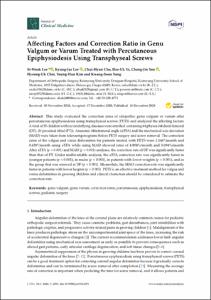KUMEL Repository
1. Journal Papers (연구논문)
1. School of Medicine (의과대학)
Dept. of Orthopedic Surgery (정형외과학)
Affecting Factors and Correction Ratio in Genu Valgum or Varum Treated with Percutaneous Epiphysiodesis Using Transphyseal Screws
- Keimyung Author(s)
- Lee, Si Wook; Lee, Kyung Jae; Cho, Chul Hyun; Song, Kwang Soon
- Department
- Dept. of Orthopedic Surgery (정형외과학)
- Journal Title
- Journal of Clinical Medicine
- Issued Date
- 2020
- Volume
- 9
- Issue
- 12
- Keyword
- genu valgum; genu varum; correction rates; percutaneous; epiphysiodesis; transphyseal screws; pediatric surgery
- Abstract
- This study evaluated the correction rates of idiopathic genu valgum or varum after percutaneous epiphysiodesis using transphyseal screws (PETS) and analyzed the affecting factors. A total of 35 children without underlying diseases were enrolled containing 64 physes (44 distal femoral (DT), 20 proximal tibial (PT)). Anatomic tibiofemoral angle (aTFA) and the mechanical axis deviation (MAD) were taken from teleroentgenograms before PETS surgery and screw removal. The correction rates of the valgus and varus deformities for patients treated with PETS were 1.146°/month and 0.639°/month using aTFA while using MAD showed rates of 4.884%/month and 3.094%/month. After aTFA (p < 0.001) and MAD (p < 0.001) analyses, the correction rate of DF was significantly faster than that of PT. Under multivariable analysis, the aTFA correction rate was significantly faster in younger patients (p < 0.001), in males (p < 0.001), in patients with lower weights (p < 0.001), and in the group that was screwed at DF (p < 0.001). Meanwhile, the MAD correction rate was significantly faster in patients with lower heights (p = 0.003). PETS is an effective treatment method for valgus and varus deformities in growing children and clinical characters should be considered to estimate the correction rate.
- Publisher
- School of Medicine (의과대학)
- Citation
- Si-Wook Lee et al. (2020). Affecting Factors and Correction Ratio in Genu Valgum or Varum Treated with Percutaneous Epiphysiodesis Using Transphyseal Screws. Journal of Clinical Medicine, 9(12), 4093. doi: 10.3390/jcm9124093
- Type
- Article
- ISSN
- 2077-0383
- Source
- https://www.mdpi.com/2077-0383/9/12/4093
- Appears in Collections:
- 1. School of Medicine (의과대학) > Dept. of Orthopedic Surgery (정형외과학)
- 파일 목록
-
-
Download
 oak-2020-0757.pdf
기타 데이터 / 1.86 MB / Adobe PDF
oak-2020-0757.pdf
기타 데이터 / 1.86 MB / Adobe PDF
-
Items in Repository are protected by copyright, with all rights reserved, unless otherwise indicated.